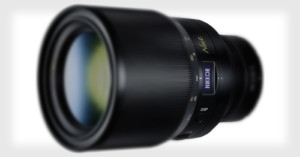
Wide Lenses Were Created Especially to Film Close-Ups in ‘Oppenheimer’
Christopher Nolan's love affair with IMAX cameras is no secret and the director's enthusiasm for them caused new lenses to be created.

Christopher Nolan's love affair with IMAX cameras is no secret and the director's enthusiasm for them caused new lenses to be created.

Your iPhone can nicely blur the background to enhance a photograph or video. A similar effect works well with video chat software, eliminating distractions and putting the focus on the subject. Whether you want to blur the background during a FaceTime call, snap a beautiful portrait photograph with your iPhone, or edit the background blur in pictures you've already captured, we'll explain how it works to help you get the blur you want from your iPhone.

A new nanophotonic light field camera based on the eye of a Cambrian-era sea creature can combine macro and telephoto magnification into one lens with unlimited depth of field.

Macro photography works well with conventional lenses and inexpensive extension tubes. The combination achieves 0.3x to 0.5x magnification. Depth of field is much greater with these moderate magnifications than at the 1x magnification possible with macro lenses.

Recently, the more I study my photographs, the more I feel that bokeh is cheating me out of a more substantial image. I really like photographs with a lot of visual complexity -- well presented, not chaotic, but a clear arrangement of multiple elements.

We all know that reducing aperture increases depth of field, but how much does that help? Here are some facts about depth of field.

The folks over at YouTube channel Media Division recently put together an incredibly comprehensive test of the fastest camera lenses on the market. In this video, they cover everything from the legendary Zeiss R-Biotar 100mm f/0.73 X-Ray lens, to some of the more "practical" options with maximum apertures under f/1.

A Japanese patent from Sony hints at a future lens that would allow you to shoot first, and focus your photos later. By combining multiple smaller lenses into a single larger lens, the idea could open up a world of new imaging possibilities if it ever comes to pass.

Photographer Felix Jäger recently got to review a lens that many Micro Four Thirds shooters have on their wishlist: the Voigtländer 42.5mm f/0.95. But while that mouth-watering aperture number might set your heart to racing, don't whip out your wallet just yet.

Photographer Usman Dawood of Sonder Creative recently teamed up with film photographer Adam French to put together an intriguing portrait comparison: high-resolution full-frame digital vs 4x5 large format film. They shot both cameras at about the same FF equivalent focal length, and then compared the resulting images side by side for your viewing pleasure.

Given how much more it costs to buy an f/1.4 prime compared to an f/1.8, beginners in particular often ask if the upgrade is worth it. Build quality and optical quality being equal, is the difference in light gathering capability and depth of field noticeable? Can you really tell?

In this video, I’m going to put to rest this question once and for all: does sensor size affect depth of field? I’ll be physically taking pictures with a full-frame camera and a Micro 4/3 camera, and showing you the visual difference in a range of aperture settings. There are lots of theories and opinions on this but here is the definitive answer.

When you purchase a new camera, how much time do you spend reading the manual? I find most camera manuals rather difficult to follow along with, and I for one very rarely use them. What’s interesting is that camera manuals only describe the technical “how to” side of things, like how to turn on your camera or how to attach a lens, but it doesn’t tell you how to truly become comfortable with your camera.

If you have a fast and expensive lens, it may feel like a waste to shoot portraits stopped down to f/8, f/11, or f/16. But in this 20-minute video, photographer Miguel Quiles explains why he often opts to shoot stopped down instead of wide open for increased depth of field and finer details and textures.

By carefully applying blur to a portrait, you can make it look like it was shot with a shallow depth-of-field using a fast (and expensive) lens. Here's a 12-minute tutorial by PiXimperfect that teaches the key to creating this faux blur in a realistic way.

Along with the announcement of Nikon’s new mirrorless Z-system was the development announcement of a 58mm f/0.95 Noct lens. The Z-mount’s huge inner diameter of 55mm (the F-mount has a 44mm diameter) means more light collection capability, which enables ridiculously fast lens design. Nikon’s F-mount 58mm offering tops out at f/1.4.

First launched in the iPhone 7 Plus, Apple's 'Portrait Mode' uses depth data from dual rear cameras to generate faux blur for a shallow depth-of-field effect. Google's new Pixel 2 has a similar mode that's done with a single "dual pixel" sensor. Now Samsung has unveiled a new "dual pixel" sensor that may bring this tech to an even wider audience.

Focus stacking is a technique typically used in macro shots to achieve a large depth of field. It’s a relatively simple concept: take many images focused at slightly different distances and combine the sharp portions to a single image in post. This 6-minute video from landscape photographer Mark Denney will show you how to utilise the technique in landscape photography.

The progression that is the discovery and appreciation of photography is a journey unique to the voyager. Whether the path is walked through a textbook, an online forum, or alone, there is no two that are alike.

In this 20-minute tutorial by PiXimperfect, learn how to use Photoshop to create a realistic bokeh effect in your photo. Creating a shallow depth of field after you've taken the shot can be tricky to do convincingly, but this tutorial will show you one method for how to do it.

DSLR cameras often have a little depth of field preview button beside the lens mount. This 3-minute video by ZY Productions revisits the basics of a DSLR camera and looks at how this handy button works, as well as some lesser-known things to consider.

There is a lot of misunderstanding and confusion on the subjects of depth of field, the difference between full-frame and crop sensors, and the ‘crop factor.’

Professional looking, shallow depth of field portraits are now available to a lot more people. Earlier today, Apple released its first major iOS 10 update, and included in that update is their much-anticipated fake bokeh "depth effect" Portrait mode for iPhone 7 Plus.

Hyperfocal distance—commonly defined as "the closest distance at which a lens can be focused while keeping objects at infinity acceptably sharp"—is critical for landscape photographers who want their whole frame in focus. Here's a trick for nailing hyperfocal distance without resorting to charts or smartphone apps.

Apple released iOS 10.1 to public beta testers today, and it includes one of the most anticipated features they showed off during their iPhone 7 keynote: the "Portrait" mode that fakes a depth of field effect.

Why do the new iPhone 7 phones have to simulate a shallow depth of field? The short answer: physics.

Since I got my Nikon D7000 camera 6 years ago I’ve used it almost everyday. That is a lot of shutter clicks, 148,558 to be exact. It looks like I will be in the market for a new camera soon as the D7000 is only factory tested to 150,000 clicks. My dilemma is should I go full frame, or stick with my cropped frame?

When you focus your camera, the area around the focal distance will also be in focus. But this can fall off to blur quickly or slowly. The acceptable amount of in-focus area around what's you are focusing on is called depth of field.

Here's a new 18-minute educational video by Filmmaker IQ about the subjects of depth of field and its relationship to different lenses and sensor sizes. "Through some fundamental scientific demonstrations, we will clarify concepts like circle of confusion and lens equivalency," the video says.

Here's a tutorial on how you can create fake depth of field blur in the background of photos using something known as "Z-Depth Pass." I'm not saying that this technique is better than other methods -- because it has some problems -- but it's quite different, and some of you may learn something new.

Want to understand the concept of depth of field better? Polish photographer and programmer Michael Bemowski has created a fantastic and feature-rich online depth of field calculator and bokeh simulator that can help you wrap your mind around what's going on when you change things like focal length and aperture.

Note: This is part two of a series on depth of field. you can read part one here.
This video is seen from a third person point-of-view, perpendicular to that of what the camera user would see. Depth of field is a phenomenon of near and far, forward and backward from the point of focus. Changing our point of view rotates the axis of the depth of the field 90˚ so that we may view it laterally across the X axis. This helps us better understand the optic principles at play. The overlays in this video visually quantify the changing depth of field at the given lens setting.

The key to mastering photography is not to follow the rules but to understand them. Understanding the photographic principles that define photography is a barrier that must be broken to truly unlock your full potential as a photographer.
The problems that plague beginners are the same problems faced by the pros, that is controlling your image with the exposure triangle; shutter speed, aperture, and ISO. This article will focus on understanding depth of field (DOF).

Here's a simple little GIF that can come in handy the next time you're asked to explain how aperture and depth of field work. Created by Reddit user veedees, it shows exactly how stopping down your lens from f/1.8 all the way to f/16 translates into different depths of field.

When it comes to understanding how depth of field, focal length and other variables are affected by different film/sensor formats, it can get confusing. Fortunately, Reddit user redblue has created an incredibly useful interactive resource that will help you better visualize the factors at play by letting you change variables while swapping sensors sizes and seeing the effect in real time.
Defined by Google as, “the visual quality of the out-of-focus areas of a photographic image, especially as rendered by a particular lens,” Bokeh is a term that has become much more prominent in the past ten years or so than ever before, thanks to the photography community.

Google wants to give all Android users (or at least those running Android 4.4 and up) the opportunity to use a camera app designed by the same people who made the operating system, and so the company has decided to release a standalone 'Google Camera' app packed with a few features that will make it a very tempting download at the price of "on the house."

Editor's Note: Due to some issues with the camera, this video is very shaky at times. It didn't bother us much, but if you're easily distracted this video might annoy more than it educates you. You've been warned.
If you're just getting into the world of cameras and lenses, the term "crop factor" and phrases like "this is a 35mm equivalent lens" might still confuse you. Well, that shouldn't be the case much longer.
The video above offers a clear, concise and simple explanation of crop factor that will hopefully clear all of this up and equip you with some important knowledge that will come in handy the next time you're shopping for a lens or crop sensor body.

Photographer Nicolas Reusens has always been interested in insects, so when he purchased his first DSLR three years ago, he immediately dove into the art of macro photography. By using the technique known as focus stacking -- combining several images taken at different depths of field -- he's generated some truly eye-popping photos of creepy crawlies from all over the world.

Photographer Benjamin Von Wong shot the portrait above a couple of days ago using a Nikon D4, a $9,000 Nikon 400mm f/2.8G lens, and a few iPhones for lighting. The extremely shallow depth-of-field was achieved using 36 separate exposures and the Brenizer Method.